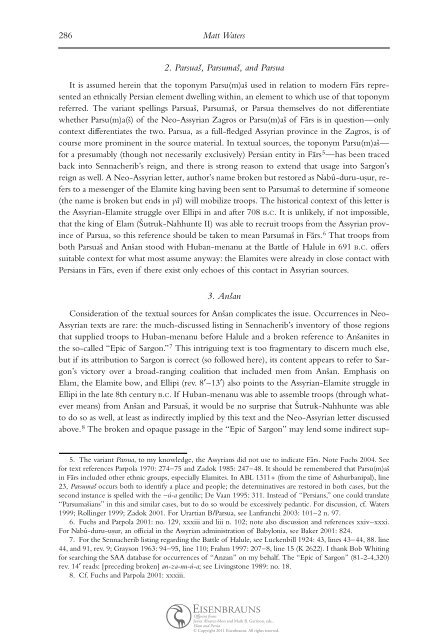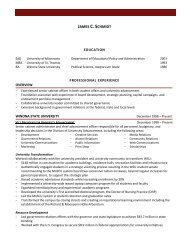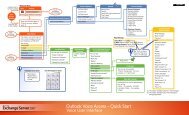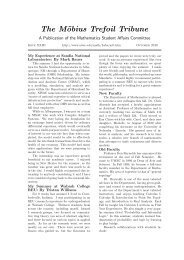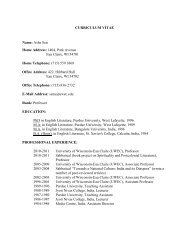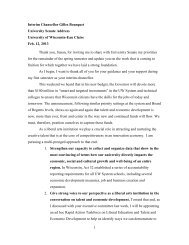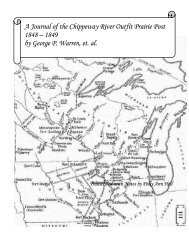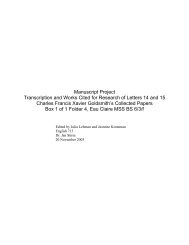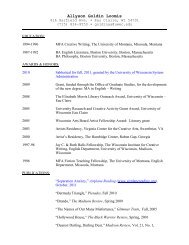Elam and Persia - University of Wisconsin-Eau Claire
Elam and Persia - University of Wisconsin-Eau Claire
Elam and Persia - University of Wisconsin-Eau Claire
Create successful ePaper yourself
Turn your PDF publications into a flip-book with our unique Google optimized e-Paper software.
286<br />
Matt Waters<br />
2. Parsuas, Parsumas, <strong>and</strong> Parsua<br />
It is assumed herein that the toponym Parsu(m)as used in relation to modern Fars represented<br />
an ethnically <strong>Persia</strong>n element dwelling within, an element to which use <strong>of</strong> that toponym<br />
referred. The variant spellings Parsuas, Parsumas, or Parsua themselves do not differentiate<br />
whether Parsu(m)a(s) <strong>of</strong> the Neo-Assyrian Zagros or Parsu(m)as <strong>of</strong> Fars is in question—only<br />
context differentiates the two. Parsua, as a full-fledged Assyrian province in the Zagros, is <strong>of</strong><br />
course more prominent in the source material. In textual sources, the toponym Parsu(m)as—<br />
for a presumably (though not necessarily exclusively) <strong>Persia</strong>n entity in Fars 5 —has been traced<br />
back into Sennacherib’s reign, <strong>and</strong> there is strong reason to extend that usage into Sargon’s<br />
reign as well. A Neo-Assyrian letter, author’s name broken but restored as Nabû-duru-ußur, refers<br />
to a messenger <strong>of</strong> the <strong>Elam</strong>ite king having been sent to Parsumas to determine if someone<br />
(the name is broken but ends in yâ) will mobilize troops. The historical context <strong>of</strong> this letter is<br />
the Assyrian-<strong>Elam</strong>ite struggle over Ellipi in <strong>and</strong> after 708 b.c. It is unlikely, if not impossible,<br />
that the king <strong>of</strong> <strong>Elam</strong> (Sutruk-Nahhunte II) was able to recruit troops from the Assyrian province<br />
<strong>of</strong> Parsua, so this reference should be taken to mean Parsumas in Fars. 6 That troops from<br />
both Parsuas <strong>and</strong> Ansan stood with Huban-menanu at the Battle <strong>of</strong> Halule in 691 b.c. <strong>of</strong>fers<br />
suitable context for what most assume anyway: the <strong>Elam</strong>ites were already in close contact with<br />
<strong>Persia</strong>ns in Fars, even if there exist only echoes <strong>of</strong> this contact in Assyrian sources.<br />
3. Ansan<br />
Consideration <strong>of</strong> the textual sources for Ansan complicates the issue. Occurrences in Neo-<br />
Assyrian texts are rare: the much-discussed listing in Sennacherib’s inventory <strong>of</strong> those regions<br />
that supplied troops to Huban-menanu before Halule <strong>and</strong> a broken reference to Ansanites in<br />
the so-called “Epic <strong>of</strong> Sargon.” 7 This intriguing text is too fragmentary to discern much else,<br />
but if its attribution to Sargon is correct (so followed here), its content appears to refer to Sargon’s<br />
victory over a broad-ranging coalition that included men from Ansan. Emphasis on<br />
<strong>Elam</strong>, the <strong>Elam</strong>ite bow, <strong>and</strong> Ellipi (rev. 8u–13u) also points to the Assyrian-<strong>Elam</strong>ite struggle in<br />
Ellipi in the late 8th century b.c. If Huban-menanu was able to assemble troops (through whatever<br />
means) from Ansan <strong>and</strong> Parsuas, it would be no surprise that Sutruk-Nahhunte was able<br />
to do so as well, at least as indirectly implied by this text <strong>and</strong> the Neo-Assyrian letter discussed<br />
above. 8 The broken <strong>and</strong> opaque passage in the “Epic <strong>of</strong> Sargon” may lend some indirect sup-<br />
5. The variant Parsua, to my knowledge, the Assyrians did not use to indicate Fars. Note Fuchs 2004. See<br />
for text references Parpola 1970: 274–75 <strong>and</strong> Zadok 1985: 247–48. It should be remembered that Parsu(m)as<br />
in Fars included other ethnic groups, especially <strong>Elam</strong>ites. In ABL 1311+ (from the time <strong>of</strong> Ashurbanipal), line<br />
23, Parsumas occurs both to identify a place <strong>and</strong> people; the determinatives are restored in both cases, but the<br />
second instance is spelled with the –ú-a gentilic; De Vaan 1995: 311. Instead <strong>of</strong> “<strong>Persia</strong>ns,” one could translate<br />
“Parsumasians” in this <strong>and</strong> similar cases, but to do so would be excessively pedantic. For discussion, cf. Waters<br />
1999; Rollinger 1999; Zadok 2001. For Urartian B/Parsua, see Lanfranchi 2003: 101–2 n. 97.<br />
6. Fuchs <strong>and</strong> Parpola 2001: no. 129, xxxiii <strong>and</strong> liii n. 102; note also discussion <strong>and</strong> references xxiv–xxxi.<br />
For Nabû-duru-ußur, an <strong>of</strong>ficial in the Assyrian administration <strong>of</strong> Babylonia, see Baker 2001: 824.<br />
7. For the Sennacherib listing regarding the Battle <strong>of</strong> Halule, see Luckenbill 1924: 43, lines 43–44, 88. line<br />
44, <strong>and</strong> 91, rev. 9; Grayson 1963: 94–95, line 110; Frahm 1997: 207–8, line 15 (K 2622). I thank Bob Whiting<br />
for searching the SAA database for occurrences <strong>of</strong> “Anzan” on my behalf. The “Epic <strong>of</strong> Sargon” (81-2-4,320)<br />
rev. 14u reads: [preceding broken] an-za-nu-ú-a; see Livingstone 1989: no. 18.<br />
8. Cf. Fuchs <strong>and</strong> Parpola 2001: xxxiii.<br />
spread is 6 points long<br />
Offprint from:<br />
Javier Álvarez-Mon <strong>and</strong> Mark B. Garrison, eds.,<br />
<strong>Elam</strong> <strong>and</strong> <strong>Persia</strong><br />
ç Copyright 2011 Eisenbrauns. All rights reserved.


